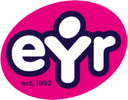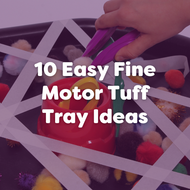10 Easy Fine Motor Tuff Tray Ideas
Posted by EYR Team on 15th Apr 2024
read more
Looking to support your little one’s fine motor skills whilst engaging in fun and playful activities? Then why not try one of our 10 fine motor tuff tray ideas? Whether you’re a parent, caregiver or educator, there is an activity for everyone to try in this blog from a pom pom pick up activity to a potting station. Read on for inspiration!
1. Pom pom pick up
How to set up:
Start by adding a selection of small resources to your tuff tray – we used pom poms but you could use whatever you have available, provided it is not to heavy or large to pick up. Next add strips of masking tape in criss-cross patterns over the edges of your tuff tray.
Aim:
The aim of this activity is for children to reach through the masking tape and retrieve the pom poms. This could be by using their hands, pincers, scoops or any other utensil.
Benefit:
- Children will develop problem solving skills as they navigate their way through the tape
- Hand-eye coordination development
- Children can practice their pincer grip and strengthen the muscles in their hands – essential for fine motor development
2. Sand writing
How to set up:
Fill a tuff tray with sand, soil or rice. Provide a range of resources to be able to “write” with. This could be brushes and twigs or you could just use your hands!
Aim:
Task your children to either replicate letters or words that you show them in the sand or ask them to produce them from memory. This activity can be adjusted depending on your child’s developmental stage.
Benefits:
- This activity can be used effectively to support other curricular learning such as number recognition for maths or letter formation for early communication, language and literacy
- Develops self-confidence – children are able to repeat and practice over and over again and mistakes are easily brushed away
- The utensils used will help to strengthen children’s muscles and build muscle memory for holding a pencil – a key requirement for later education
3. Beach clean up
How to set up:
This set up is just a guide – please feel free to use whatever resources you have to hand as the benefits will be the same. Recreate a beach scene using water, sand and other elements like fish and trees. Add some “rubbish” to your beach, we went for pretend plastic bags and straws made from string and pipecleaners.
Aim:
Task your children with “cleaning” up the beach with pincers and scoops!
Benefits:
- This activity can be used to teach children about key topics such as ocean protection and recycling
- Fine motor skills will develop as children concentrate on collecting the rubbish
4. Potting station
How to set up:
Adorn your tuff tray with a selection of resources including soil, small plant pots, seeds and plants, scoops, shovels and watering utensils
Aim:
Teach your children about gardening and responsibility for caring for plants by potting them from scratch.
Benefits:
- Children will develop a sense of responsibility as they tend to and care for their plants
- The activity can be used to teach children about nature and what plants need to survive
- The precise actions of potting and watering plants will encourage fine motor movements and therefore development
5. Construction tray
How to set up:
Fill your tray with “blocks” (these could be stones or wooden pieces found outdoors or wooden toy blocks), sand, water, foam and any other materials you have in your setting
Aim:
Provide your children with various construction related challenges such as “can you build the tallest tower?” “Can you build a castle?” Your children will be required to problem solve and select the most appropriate materials to achieve their goal.
Benefits:
- Problem solving skills. Your children will need to analyse the materials in front of them to select which will help them to achieve their goals effectively
- Fine motor development as they build and construct their masterpieces
6. Cutting practice
How to set up:
(Follow this for a Rapunzel themed tray like ours). Using chalk pens or paint, draw a tower directly onto your tuff tray. Add your cooked spaghetti to act as hair falling from the tower. Finally, add a pair of child-friendly scissors and supervise!
Aim:
Task you children with mastering their cutting skills but cutting through the spaghetti hair. Make sure there is an adult supervising at all times
Benefits:
- Children will learn to master cutting
- The act of cutting the spaghetti will work to strengthen their hand muscles and thus improve their fine motor skills
7. Minibeast hunt
How to set up:
Add soil or sand to your tray. In this, bury various small world insects and add any additional decoration you like such as twigs, moss or leaves. Finally, add a few collection pots, magnifying glasses and a selection of tongs, scoops and pincers.
Aim:
Your children will need to hunt for the minibeast hidden in the material and carefully extract them using the tongs or scoops.
Benefits:
- This activity provides children with an opportunity to discuss and learn about minibeast and creepy crawlies.
- This also provides a fun activity for children whilst simultaneously improving their grip, motor precision and hand eye coordination
8. Playdough faces
How to set up:
Add your mirror mat to your tuff tray and add various pots of playdoh or clay for children to access.
Aim:
Children will need to look into the mirror and manipulate the playdoh to recreate their reflection, focusing on key features such as their eyes, ears, mouth and nose.
Benefits:
- This activity provides a great opportunity for children to learn more about their bodies and functions of certain features
- Playdoh is an excellent material with which to strengthen hand muscles required for fine motor skills
- Manipulating the playdoh into the correct shapes and forms requires fine motor skill which will develop as the activity is completed
9. Ice melting
How to set up:
Freeze various objects overnight – we chose flowers and other natural resources but you could try anything that will capture your little ones interests! Add these frozen objects to your tuff tray with toy hammers, brushes, salt and other tools.
Aim:
Task your children with melting or cracking the ice to recover the object frozen inside using whatever means they choose!
Benefits:
- Children will learn to problem solve as they find the most effective tools to free their objects from the ice
- Working their way through the ice will require muscle strength in your children’s hands which will help to support fine motor development and control.
10. Mindfulness
How to set up:
Lay your tuff tray on the floor and add your tuff tray paper pad. Draw a selection of long lines from one side of the paper pad to the other. Try using different patterns such as straight lines, zig zag and wavy lines
Aim:
Encourage children to follow the different lines with their fingers and align their breath to the pattern to practice mindful breaths
Benefits:
- This activity will teach children calming mindfulness techniques that will help them to regulate their breathing and manage their emotions
- Tracing the various lines is a great pre writing exercise that will benefit children in later writing exercises
We would love to know which of these fine motor tuff tray activities you have tried! Let us know by tagging us on social media or using the hashtag #ExploreWithEYR.
Looking for tuff tray resources? Browse all trays, mats, kits and accessories below!
































